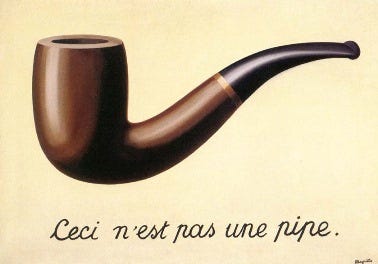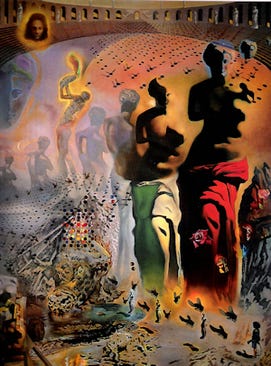Surrealism: Unravelling Bullshit, Subjectivity and Perception
In a world saturated with a never-ending flow of information, where images and narratives often collide with our understanding of truth, Harry Frankfurt’s insights provide a compelling lens through which we may view contemporary culture. His famous essay, On Bullshit (1986), is a real page turner. It essentially dissects the nature of modern discourse, revealing how a lack of concern for truth can create a profound and damaging disconnect between reality and perception.
Interestingly, surrealist art resonates deeply with Frankfurt’s thesis, offering a visual manifestation of the complexities surrounding authenticity and illusion. Surrealism and Frankfurt both invite us to question what we perceive empirically, or through our senses, and to look beyond the surface. So here I am, attempting to share how these ideas intertwine and challenge our perceptions of truth.
Disclaimer: I’m going to be dropping the word "bullshit" like confetti at a parade. So, if this is not your thing, you might want to skip this one.
What is Bullshit?
At its core, Frankfurt’s definition of bullshit hinges on indifference to truth. He argues that while liars are aware of the truth they distort, those who engage in bullshit disregard it entirely. This makes bullshit particularly insidious; it thrives on superficiality and illusion, often creating a façade, or an impression, that obscures reality. In a society increasingly driven by image and appearances—via social media, advertising, and political rhetoric—the implications of Frankfurt's argument resonate more than ever.
A heated political speech - think Hitler or Mussolini, for instance - does not aim to say how the world is in reality. Its sole purpose is to make the speaker sound like a patriot, and a “protector” of the people, who holds the populace’s best interests at heart. This is how most politicians want to be perceived, however, it may not be the reality of what they “are”. For Frankfurt, bullshit is about a hoped-for short-term effect that will benefit the bullshitter, with total disregard for durability. The bullshit artist does not purposefully lie, but rather, spins facts in a manner that supports or justifies a rhetoric, ideology, agenda, etc. In this sense bullshit is defined by perception and illusion.
Subversing Reality
Now that we have covered the concept of bullshit, let us take a look at how the subversion of reality is represented in visual art. No artistic movement is more closely connected to the themes of perception and illusion than surrealism. Emerging in the early 20th century, surrealism aimed to challenge conventional views of reality.
Artists like Salvador Dalí (1904-1989), René Magritte (1898-1967), André Masson (1896-1987), and Max Ernst (1891-1976) use dreamlike imagery and bizarre juxtapositions to tap into the unconscious mind and expose the malleability of the mind - and human perception. Their works often defy logic and provoke a sense of wonder, leading us to question what is real and what is an illusion. In this sense, surrealism serves as a visual counterpart to Frankfurt's ideas: it draws attention to the constructed nature of reality and challenges us to discern truth from deception.
Juxtaposing Truth and Illusion
One of the hallmarks of surrealist art is its ability to juxtapose contrasting elements, creating a visual tension that elicits feelings of uneasiness and disorientation. For instance, Magritte's The Treachery of Images features a pipe with the declaration "Ceci n'est pas une pipe". This illustration challenges our assumptions about representation, emphasizing the difference between an object and its depiction - we see something and yet we are told it is not reality. This interplay mirrors Frankfurt's assertion that bullshit often obscures the truth by focusing on surface impressions rather than a genuine understanding of truth. Do not take what you see at face value!
The Treachery of Images, René Magritte (1929)
Dalí’s The Persistence of Memory, another hallmark of surrealist art, presents melting clocks in a dreamlike landscape, prompting us to grapple with the fluidity of time and reality. By presenting clocks that appear to be melting, Dalí confronts viewers with a paradox. These clocks represent time, yet their distorted forms suggest that what we consider "real" can be manipulated. Time is melting, which means it’s not a fixed, absolute concept as we typically think of it. Instead, it’s a subjective experience that can vary based on perception.The best way to illustrate this subjectivity would be to say that time goes “slowly” when we are young, and it moves “faster” as we age.
The Persistence of Memory, Salvador Dalí (1931)
This illusion casts doubt on the reliability of our perceptions and the truths we take for granted, echoing Frankfurt’s warning against accepting appearances at face value. Just as a bullshitter shapes narratives to fit a desired impression, surrealist artists construct visual worlds that challenge our perceptions and compel us to question what we accept as real.
Similarly, in Dalí’s The Hallucinogenic Toreador, the toreador’s figure appears distorted and moving, creating visual instability. This distortion suggests that reality can be warped and what we see is not as solid as it seems.
The Hallucinogenic Toreador, Salvador Dalí (1970)
Additionally, the painting incorporates multiple overlapping images, such as hidden faces in the background, inviting us to see and simultaneously experience different iterations of the same figure. This repetition emphasizes the subjective nature of reality, highlighting how perception is personal and influenced by our own feelings and experiences. Essentially, reality can be perceived in multiple diverging manners by different viewers. This take on the subjectivity of perception and the subversion of reality is not far removed from Frankfurt’s premise on bullshit. As one of my good friends always says, there are always three versions of the truth “yours, mine, and reality”.
Challenging Conventions
Surrealism also serves as a critique of societal norms, much like Frankfurt’s critique of discourse. By subverting our visual expectations and pushing the boundaries of subject matter, surrealist artists expose the absurdities of everyday life. Max Ernst’s Celebes, featuring a giant mechanical elephant in a desolate landscape, evokes feelings of fascination and unease. This emphasis on what is mechanical rather than what is alive reflects the artificiality of the constructed world, echoing Frankfurt’s insights into how bullshit obscures the objective truth. Well spun narratives can often be more convincing than reality - as is this robotic figure posing as a live elephant.
As society grapples with misinformation and superficial narratives, surrealism invites us to confront the absurdities and contradictions that define our reality. Bullshit is everywhere in our modern world, largely because we’ve shifted from valuing “correctness” to prioritizing “sincerity.” In this relativistic environment, a well-articulated message can overshadow the truth simply because it feels sincere, even if it lacks objective correctness. This phenomenon makes surrealist art a compelling means of expressing the disillusionment that often arises from living in a world filled with such superficiality and distortion.
What to make of this?
In our current landscape, where the lines between truth and perception are increasingly blurred, the insights of Harry Frankfurt alongside the evocative power of surrealist art serve as essential tools for navigating the complexities of reality. As we dissect Frankfurt's concept of bullshit—its indifference to truth and the superficial narratives it spins—we find a striking parallel in the works of surrealist artists, who challenge our perceptions and compel us to question the authenticity of our experiences. Through the distorted forms and dreamlike imagery of artists like Dalí and Magritte, we are reminded that what we see is not always what is real, and that our interpretations can be heavily influenced by context and emotion.
Ultimately, both Frankfurt's philosophical inquiries and surrealism invite us to engage in a deeper reflection on the nature of truth. They challenge us to peel back the layers of illusion that permeate our daily lives, encouraging us to seek authenticity amid the chaos of modern discourse.
Embrace the absurd, question the ordinary, and let art guide you toward an understanding of what it means to truly see.





